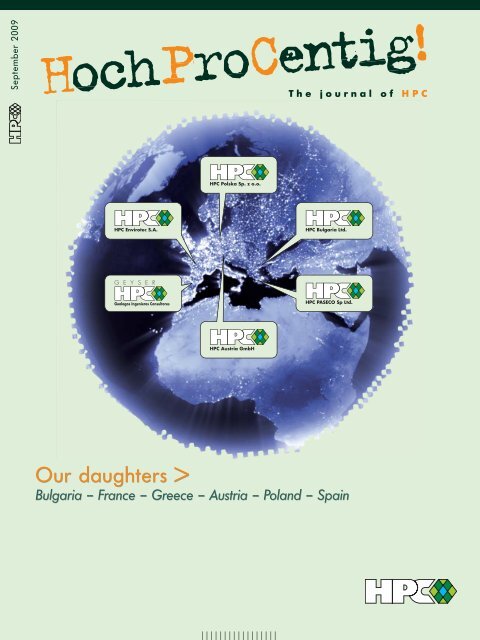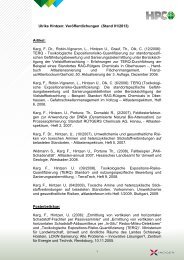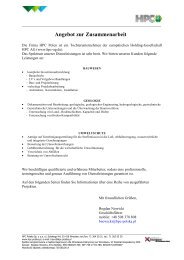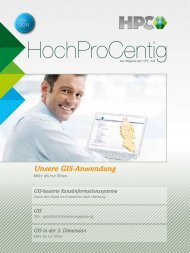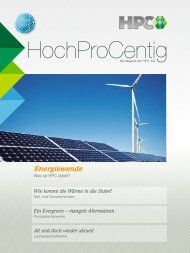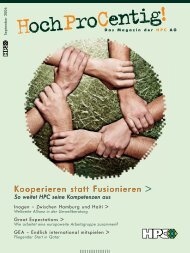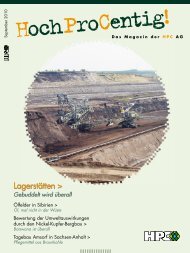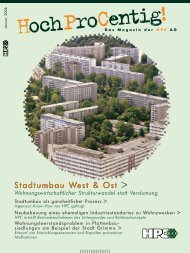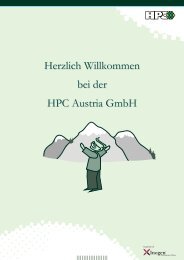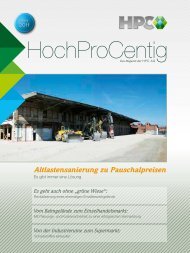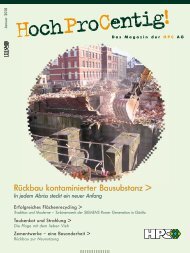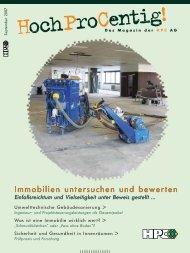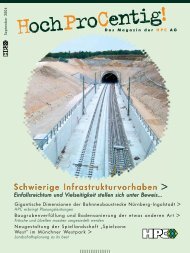France – Greece – Austria – Poland - HPC AG
France – Greece – Austria – Poland - HPC AG
France – Greece – Austria – Poland - HPC AG
Create successful ePaper yourself
Turn your PDF publications into a flip-book with our unique Google optimized e-Paper software.
September 2009<br />
<strong>HPC</strong> Envirotec S.A.<br />
G E Y S E R<br />
Geologos Ingenieros Consultores<br />
Our daughters ><br />
<strong>HPC</strong> Polska Sp. z o.o.<br />
<strong>HPC</strong> <strong>Austria</strong> GmbH<br />
The journal of <strong>HPC</strong><br />
<strong>HPC</strong> Bulgaria Ltd.<br />
<strong>HPC</strong> PASECO Sp Ltd.<br />
Bulgaria <strong>–</strong> <strong>France</strong> <strong>–</strong> <strong>Greece</strong> <strong>–</strong> <strong>Austria</strong> <strong>–</strong> <strong>Poland</strong> <strong>–</strong> Spain
Editorial<br />
Invitation<br />
DAUGHTERS AND DAUGHTERS-<br />
IN-LAW<br />
The reason I vividly remember the foundation<br />
of <strong>HPC</strong>’s first foreign subsidiary is<br />
that my own son was born just at the<br />
same time, right at the upper reaches of<br />
the Ohio River. Inspired by the spirit of<br />
the pioneers and improvising in every<br />
respect, we moved into a nine metres<br />
room which was to serve as office, equipment<br />
storage and library. In broken<br />
English we convinced the US Americans<br />
that finally somebody competent had appeared<br />
to solve environmental problems.<br />
Since then, more than two decades have<br />
passed and the world has changed <strong>–</strong> and<br />
with it <strong>HPC</strong> <strong>AG</strong>. All who witnessed the first<br />
international attempts at walking will to-<br />
2 www.hpc.ag <strong>HPC</strong>, September 2009<br />
day surely be amazed when looking at the<br />
map of Europe on <strong>HPC</strong>’s homepage: the<br />
parents didn’t waste their time.<br />
Well, usually children are not born unintentionally<br />
and transferred to a company<br />
this means that there are strategic considerations.<br />
On the one hand, we fancy a piece of the<br />
cake to be distributed in developing markets.<br />
On the other, many competitors have<br />
the same appetite. To spearhead, we have<br />
to add some more competitive advantages,<br />
and there do not exist too many in<br />
the consulting business. The few of them<br />
include technology, competence and the<br />
quality of serving clients. On an international<br />
level, add aspects of culture and language,<br />
which may be obstacle and possibility<br />
at the same time.<br />
For multinational companies globalization<br />
already started a couple of decades ago,<br />
long before it was properly conceived by<br />
general public. In recent times, worldwide<br />
environmental awareness, transparency in<br />
business practices and corporate governance,<br />
i.e. the ethic behavior of a company,<br />
have gained more and more importance.<br />
We can no longer afford to observe<br />
strict rules in one country and negate<br />
them in the other. Constraints are also<br />
Bayerische Wassertage 2009<br />
November 11 th and 12 th 2009<br />
http://www.kumas.de<br />
posed by efforts of purchasing departments<br />
to restrict the number of suppliers.<br />
Most clients favor service providers who<br />
are able to act worldwide on a consistently<br />
high level and who are familiar with local<br />
mannerisms. To meet these demands and<br />
profit thereof, veritable monster consultancies<br />
have developed. So far, almost all<br />
of these consultancies failed in integrating<br />
staff of the most various nations on all<br />
levels and in trying to evoke team spirit<br />
characterized by fellowship and communication<br />
in order to serve clients by maintaining<br />
quality standards beyond borders.<br />
For me it seems that <strong>HPC</strong> has found a<br />
unique composition by the duplicity of an<br />
own, European expansion and a partnership<br />
with Inogen.<br />
Daughters and daughters-in-law, if you<br />
want. Both belong to one family. Let us<br />
hope that all <strong>HPC</strong> members of staff will<br />
soon see themselves as part of an international<br />
company <strong>–</strong> and that HochProCentig!<br />
appears in several languages.<br />
Dr. Dieter Hiller<br />
Schlumberger Water Services<br />
<strong>France</strong>
2 EDITORIAL<br />
4 <strong>HPC</strong> AUSTRIA<br />
5 <strong>HPC</strong> BULGARIA<br />
7 <strong>HPC</strong> POLAND<br />
9 GEYSER <strong>HPC</strong> SPAIN<br />
10 <strong>HPC</strong> GREECE<br />
11 <strong>HPC</strong> ENVIROTEC FRANCE<br />
13 INFORMATION RETRIEVAL<br />
What’s your opinion on the subject?<br />
15 <strong>HPC</strong> ENVIROTEC FRANCE<br />
(sequel)<br />
16 CONTACT ADRESSES<br />
Imprint<br />
Table of contents<br />
<strong>HPC</strong>, September 2009 www.hpc.ag<br />
3
<strong>HPC</strong> <strong>Austria</strong> GmbH <strong>–</strong><br />
new affiliate in <strong>Austria</strong><br />
<strong>HPC</strong> <strong>Austria</strong> GmbH<br />
<strong>HPC</strong> <strong>Austria</strong> GmbH<br />
Schlossplatz 13<br />
A-2361 Laxenburg<br />
LAXENBURG <strong>–</strong> Since 2006, the <strong>HPC</strong><br />
Group has again been operating in <strong>Austria</strong><br />
with an own subsidiary (<strong>HPC</strong> <strong>Austria</strong><br />
GmbH). First and foremost the new<br />
company was founded to serve the MSA<br />
with BP and the client’s wish to implement<br />
this agreement with local staff.<br />
Originally, the founding location of the<br />
company was Heiligenstaedterstrasse in<br />
Vienna (as subtenant of the acquainted<br />
ÖSTAP Engineering & Consulting). However,<br />
soon we developed a need to grow<br />
as far as staff was concerned and therefore<br />
had to look for own and particularly more<br />
spacious office locations. For infrastructural<br />
reasons we decided to move to the<br />
southern outskirts of Vienna (to Laxenburg,<br />
cf. photo, offices are located on the<br />
ground floor).<br />
In the meantime, <strong>HPC</strong> <strong>Austria</strong> GmbH has a<br />
staff of seven specializing in different fields<br />
of service (cf. photos).<br />
After our starting phase, where we were<br />
exclusively occupied with the completion<br />
of BP projects, we now serve also clients<br />
4 www.hpc.ag <strong>HPC</strong>, September 2009<br />
Ing. Christian<br />
Gikopoulos,<br />
branch manager,<br />
environmental<br />
engineer<br />
Mag. Peter<br />
Raumauf, MBA<br />
egsm., geologist<br />
Bettina Bruckner<br />
assistant<br />
<strong>HPC</strong> <strong>Austria</strong><br />
from other industries: we provide support<br />
to small landfill operators in implementing<br />
alternative landfill gas containment concepts<br />
(passive landfill gas treatment) and<br />
to filling station operators in monitoring<br />
compliance with maximum values according<br />
to the indirect discharge ordinance of<br />
the <strong>Austria</strong>n water law.<br />
End of last year we were awarded the<br />
contract to carry out the first toxicological<br />
exposition risk evaluation in <strong>Austria</strong> on an<br />
abandoned contaminated site for the<br />
Dr. Maria dos<br />
Santos, geological<br />
scientist<br />
Dipl. Ing. Rafael<br />
Smutny, hydrobiologist<br />
(water<br />
management)<br />
Dipl. Geologe<br />
Bjoern Lehr,<br />
hydro-geologist<br />
Lower <strong>Austria</strong>n Federal Government in<br />
cooperation with the Federal Environmental<br />
Agency.<br />
Assessment of the toxicological<br />
exposition risk for residents in the<br />
course of further investigations<br />
according to §14 ALS<strong>AG</strong> <strong>Austria</strong>n<br />
Act on Remediation of Contaminated<br />
Sites by TERQ: Toxicological<br />
Exposition Risk Quantification<br />
From 1860 to 1924, the project area was<br />
used for tar chemicals production and<br />
wood impregnation. After 1945, construction<br />
activities started on the abandoned<br />
site. Today, residential houses are located<br />
on wide areas of the site which have partly<br />
been built using construction material of<br />
the former factory facilities. The eastern<br />
part of the study area adjoins the railway<br />
station of Angern and is used as storage<br />
area for sugar beets. The former storage<br />
areas of wood impregnation in the southwestern<br />
area are presently used for agricultural<br />
purposes.<br />
Mag. Sascha Salek,<br />
geologist
In the course of investigation carried out<br />
from 1999 to 2002, massive contamination<br />
of subsoil and groundwater (mainly by tar<br />
oils and arsenic) was determined on the<br />
area of the former tar factory and wood<br />
impregnation facility. For the first time in<br />
<strong>Austria</strong>, an exposition risk assessment to<br />
determine the toxicological exposition<br />
risks for residents was to be carried out as<br />
further investigation.<br />
Additionally, the results of the assessment<br />
were to provide for priority classification<br />
according to §14 ALS<strong>AG</strong>, the <strong>Austria</strong>n Act<br />
on Remediation of Contaminated Sites.<br />
To evaluate direct and indirect intake of<br />
contaminants from soil, ground-, surface<br />
and drinking water, fruit and vegetables,<br />
all relevant exposure paths are taken into<br />
account. Target of the assessment is to<br />
quantify the toxicological exposition risk<br />
for residents on site and on downgradient<br />
areas.<br />
<strong>HPC</strong> <strong>Austria</strong> GmbH (in cooperation with<br />
the R&D Division of the <strong>HPC</strong> Group) was<br />
retained by the Federal Ministry of Agriculture,<br />
Forestry, Environment and Water<br />
Management to carry out this toxicological<br />
risk evaluation.<br />
The following investigation phases<br />
were/are carried out during the project:<br />
<strong>–</strong> Evaluation and interpretation of<br />
existing investigations and detailing of<br />
investigation measures planned<br />
<strong>–</strong> Site visits and interviews to obtain information<br />
on present use of properties<br />
in order to define exposition scenarios<br />
<strong>–</strong> Planning and recovery of soil, plant,<br />
domestic dust and indoor air samples<br />
<strong>–</strong> Assessment of the toxicological exposition<br />
risk for residents by TERQ<br />
The project was planned to be completed<br />
by 2011. Whether an expansion of the<br />
investigation site to downgradient areas<br />
will be carried out has so far not been<br />
decided.<br />
Christian Gikopoulos,<br />
cgikopoulos@hpc-austria.at<br />
The tar factory about 1920.<br />
(http://www.umweltbundesamt.at/umweltschutz/altlasten/altlasteninfo/altlasten3/niederoesterreich/n53/)<br />
<strong>HPC</strong> Bulgaria Ltd. <strong>–</strong> the representative<br />
of <strong>HPC</strong> at Balkan Peninsula<br />
Who are we?<br />
1999 <strong>–</strong> <strong>HPC</strong> HARRESS PICKEL CONSULT<br />
<strong>AG</strong> is awarded to execute a project, funded<br />
by the PHARE Program of the EC on<br />
the Waste Management of radiaoctive contaminated<br />
water in the former uranium<br />
production region Buhovo near Sofia, the<br />
capital of Bulgaria. The project is successful<br />
and prospects are looking good for<br />
<strong>HPC</strong> in Bulgaria, so <strong>HPC</strong> <strong>AG</strong> decides to<br />
establish a subsidiary to act in this promissing<br />
region of Europe.<br />
SOFIA <strong>–</strong> At the end of the year 2000<br />
<strong>HPC</strong> Bulgaria Ltd. is born. The company<br />
starts with only two persons <strong>–</strong> the General<br />
Manager Dr. Hanspeter Tomschi and the<br />
country Office Director Dr. Ljubka Kostova.<br />
Dr. Kostova will turn out as the company’s<br />
driving force in Bulgaria. As nuclear<br />
physicist and one of the most esteemed<br />
radiation protection specialists she brings<br />
in her widespread know-how.<br />
<strong>HPC</strong> Bulgaria<br />
<strong>HPC</strong> Bulgaria performs a flying start: the<br />
participation in the first tender bid is<br />
successful. The Bulgarian Ministry of Environment<br />
and Water assigns the company<br />
with the provision of technical support in<br />
connection with the project “Wetlands Restoration<br />
along Danube River”.<br />
The Project is inspired by the Ramsar<br />
Convention and is funded by the World<br />
Bank. The works are completed in a very<br />
short time to the full satisfaction of the<br />
client.<br />
In the following years <strong>HPC</strong> Bulgaria grows<br />
and becomes stronger on this new and<br />
upcoming market in South-East Europe.<br />
The Company is active not only in Bulgaria,<br />
it supports as well the mother company<br />
and the partners of the INOGEN<br />
Alliance in Romania, Russia, Aserbeidjan in<br />
different projects of the EC programms,<br />
World Bank and multinational clients.<br />
New E 79 some days before the official<br />
taking over<br />
What are we doing?<br />
A glance in the past ... February 2006 <strong>–</strong><br />
On the newly-constructed road section on<br />
the E 79, north of Dimovo/Bulgaria, several<br />
days before the official taking over<br />
subsidence occurred. The Contractor, an<br />
established European construction company<br />
and the Bulgarian authorities were<br />
shocked. The road is an important connection<br />
from North to South border of the<br />
country and the works are funded by the<br />
European community pre-accession<br />
program <strong>–</strong> PHARE.<br />
<strong>HPC</strong>, September 2009<br />
<strong>HPC</strong> Bulgaria Ltd.<br />
<strong>HPC</strong> Bulgaria Ltd.<br />
Antim I, No. 53, Et. 4<br />
BG-1303 Sofia<br />
Branch manager:<br />
Dr. Ljubka Kostova<br />
www.hpc.ag<br />
5
Nobody from the Bulgarian engineering<br />
companies is willing to conduct the investigations<br />
in such short terms and to take<br />
the responsibility in this case. <strong>HPC</strong> Bulgaria,<br />
confident in its own ability, is ready<br />
to act. Together with the German colleagues<br />
from <strong>HPC</strong> Merseburg the Bulgarian<br />
experts suggested an iterative approach,<br />
starting with some basic field and laboratory<br />
investigations and leading to a definition<br />
of measures, suitable to reconstruct<br />
the damaged road section.<br />
In the next four weeks the following<br />
activities have been executed:<br />
<strong>–</strong> Collection and analysis of archive data<br />
and information<br />
<strong>–</strong> Complete geological, engineering<br />
geological and hydrogeological mapping<br />
of the region in the surroundings<br />
of the road fracture<br />
<strong>–</strong> Design and execution of an investigation<br />
program regarding the earth structure<br />
of the embankment and its<br />
foundation, humidity content, its degree<br />
of compaction and ground water<br />
situation<br />
<strong>–</strong> Analysis of the investigation data and<br />
modelling<br />
<strong>–</strong> Elaboration of a report with proposal<br />
for remedial action<br />
The recommendations of the <strong>HPC</strong> experts<br />
were explicit and realisable, so the road<br />
could be repaired in a short time.<br />
And today ... January 2007 <strong>–</strong> Bulgaria becomes<br />
a member of the European Union.<br />
According to the Accession Contract the<br />
country is obliged to apply the requirements<br />
of Directive 91/271/EEC concerning<br />
urban wastewater treatment and the requirements<br />
of the Directive 75/442/EEC<br />
and 1999/31/EEC concerning the waste<br />
management.<br />
In order to support Bulgaria in implementing<br />
these so called “investment heavy” EU<br />
Directives dealing with the water, waste<br />
water and waste management, the<br />
European Union starts the Operational<br />
programme ”Environment 2007<strong>–</strong>2013”<br />
immediately after the Bulgarian accession.<br />
6 www.hpc.ag <strong>HPC</strong>, September 2009<br />
<strong>HPC</strong> Bulgaria<br />
In order to support the Bulgarian municipalities<br />
in applying and executing their<br />
projects, consultants who are liable to<br />
solve complex problems regarding the<br />
water supply, sewerage sector development<br />
and waste management are highly<br />
needed. Supported by the colleagues from<br />
the mother company <strong>HPC</strong> <strong>AG</strong> and together<br />
with the well chosen Bulgarian part<br />
ners at the moment <strong>HPC</strong> Bulgaria is executing<br />
several projects funded by the<br />
operational programme ”Environment<br />
2007<strong>–</strong>2013”. In the following, two of these<br />
projects are described in brief:<br />
Dupnitsa waste water treatment<br />
plant<br />
Dupnitsa is a municipality with 55,000<br />
inhabitants situated at the foot of Rila<br />
Mountain, 70 km south-western of the<br />
country’s capital, Sofia. The waste water<br />
treatment plant was constructed at the<br />
beginning of 80-ies and has been in operation<br />
for nearly 30 years now.<br />
Dupnitsa waste water treatment plant<br />
Due to a lack of money the investments<br />
during the last 20 years were massively<br />
reduced. The facility is not only out of<br />
date, but also in poor condition. It needs<br />
urgently investments for reconstruction<br />
and modernization. The new technical<br />
solutions shall be efficient, in compliance<br />
with the EC directives, cost and environmentally<br />
friendly.<br />
<strong>HPC</strong> Bulgaria provides such consultant<br />
services for preparation of a complete<br />
investment project for reconstruction,<br />
modernization and enlargement of Dupnitsa<br />
WWTP, including financial analyses<br />
and environmental expertise and finalizing<br />
the investigation results in an Application<br />
form for funding by the EC Cohesion<br />
fond.<br />
Kneja land fill<br />
The Kneja municipality is located in the<br />
North of the Balkan mountain and consists<br />
of the town of Kneja and three villages.<br />
Kneja land fill<br />
The population is about 17,000. Up to<br />
now there is no system for the domestic<br />
waste management. The only landfill does<br />
not correspond to the legal requirements<br />
and shall be closed. The municipally<br />
needed urgently a comprehensive solution<br />
for the treatment of the generated solid<br />
waste and applies for the technical<br />
support for this issue. <strong>HPC</strong> Bulgaria is<br />
awarded to carry out the feasibility study,<br />
concept development for an integrated<br />
waste management system, cost-benefit<br />
analysis, environmental impact assessment<br />
and the preparation of the application<br />
form for further investment. Along the<br />
way, <strong>HPC</strong> Bulgaria carries out the investigation<br />
of the existing landfill and will<br />
propose a cost-effective remediation<br />
concept.<br />
<strong>HPC</strong> Bulgaria has now gained a leading<br />
position with its highly qualified specialists<br />
and experience in the sectors water, waste<br />
water and waste management. Today <strong>HPC</strong><br />
Bulgaria has 14 employees <strong>–</strong> engineers,<br />
chemists, biologists, and environmentalists,<br />
lead by the <strong>HPC</strong> Bulgaria general<br />
manager <strong>–</strong> Geol. Goetz Heckmann and<br />
the executive director <strong>–</strong> Dr. Ljubka<br />
Kostova. <strong>HPC</strong> Bulgaria is ready to meet<br />
the highest client requirements in the field<br />
of infrastructural planning and environmental<br />
protection. Based on this solid<br />
foundation we are able and willing to<br />
support Bulgaria’s efforts to fulfil environmental<br />
standards specified by EU regulations.<br />
Ljubka Kostova,<br />
lkostova@hpc-ag.de
<strong>HPC</strong> <strong>Poland</strong><br />
<strong>HPC</strong> Polska Sp. z o.o. <strong>–</strong><br />
innovation and new investments<br />
WROCLAW <strong>–</strong> <strong>HPC</strong> Polska Sp. z o.o. was<br />
founded in 2007 as a result of the expansion<br />
of <strong>HPC</strong> Harress Pickel Consult <strong>AG</strong> on<br />
the eastern European market. The company<br />
has chosen as its headquarters Wroclaw,<br />
a city open to innovation and new<br />
investment. The company employs experienced<br />
and highly qualified workers in<br />
the following sectors: architecture, construction,<br />
geology, installation design,<br />
environmental protection and occupational<br />
safety. Thanks to this we are able to<br />
offer our clients a broad range of services,<br />
including:<br />
<strong>–</strong> Comprehensive customer-care in implementing<br />
industrial investments,<br />
covering i.a. obtaining suitable construction<br />
sites, geological assessments,<br />
geodesic work, design services<br />
(from presenting a proposal to submitting<br />
a finished design), obtaining<br />
relevant permits, making detailed<br />
drawings, organising tenders and inspections<br />
by investors and project<br />
management.<br />
<strong>–</strong> Environmental protection services:<br />
The question of environmental protection<br />
is encountered at every stage<br />
of the investment. Our company<br />
offers assistance in meeting legal requirements,<br />
beginning with drafting<br />
environmental-impact assessments<br />
and preparing applications for the<br />
following kinds of permit: to emit<br />
substances into the atmosphere, to<br />
produce waste, water-law or integrated<br />
permits; and for the exploitation<br />
of the investment in accordance with<br />
legal provisions <strong>–</strong> pollution measurements,<br />
calculation of fees for the commercial<br />
use of the environment, drafting<br />
of waste records. Beyond this we<br />
also conduct ecological audits and<br />
offer consultancy services on environmental<br />
protection law and environmental<br />
protection projects.<br />
<strong>–</strong> Occupational health and safety (OHS)<br />
services:<br />
It is the duty of every employer to ensure<br />
safe working conditions for their<br />
employees. Our OHS specialists adapt<br />
the workplace to conform to formal<br />
and legal requirements through the<br />
correct labelling of workspaces, the<br />
drafting of instructions for evacuations,<br />
guidelines for emergencies and<br />
instructions for the safe use of equipment.<br />
We organise OHS training as<br />
well as specialist personnel training.<br />
e.g. on the safe removal of asbestos.<br />
We conduct occupational hazard analyses<br />
for particular jobs as well as OHS<br />
audits.<br />
IPPC (integrated permit) for the<br />
market leader in the production of<br />
buses in <strong>Poland</strong><br />
The provisions of Council Directive<br />
96/61/EC on Integrated Pollution Prevention<br />
and Control (IPPC), one of the most<br />
important acts of European Union law in<br />
the area of environmental protection,<br />
largely transposed into the Polish environmental<br />
protection act, introduced into<br />
Polish legislation a new legal instrument<br />
<strong>–</strong> the integrated permit, an administrative<br />
decision which is a certain form of licence<br />
for conducting industrial activity, and subsequently<br />
a fundamental change in the<br />
approach to issuing environmental permits,<br />
which in the past separately considered<br />
emissions into the atmosphere, noise,<br />
discharge of waste, radiation emissions<br />
and waste generation.<br />
Work is based on gathering essential<br />
information enabling the drafting of:<br />
the information and description<br />
part, containing i.a.:<br />
a) general information on the subject of<br />
the application (types of installations,<br />
their character, production profile, organisational<br />
and employment structure,<br />
bodies responsible for environmental<br />
protection etc.);<br />
b) characteristics of the installations<br />
being used (technical characteristics<br />
of the installations and equipment,<br />
technology used, variations of their<br />
operation, energy characteristics,<br />
technical condition, water consumption,<br />
types of emissions <strong>–</strong> into the atmosphere,<br />
discharge of waste water,<br />
production of waste, noise, electromagnetic<br />
radiation, risk of an industrial<br />
accident occurring; characteristics<br />
regarding the impact of the plant on<br />
the environment);<br />
Site of the plant covered by the IPPC<br />
permit<br />
The operational part of the application,<br />
where the following are described:<br />
a) ways of preventing and/or controlling<br />
the impact on the environment (protection<br />
of the water environment, atmosphere,<br />
protection from noise,<br />
protection from encumbrances connected<br />
with the emission of waste,<br />
protection from electromagnetic radiation,<br />
holistic environmental protection<br />
methods, environmentally safe<br />
completion of installation and equipment<br />
operations, monitoring)<br />
b) the proposed admissible emissions<br />
and environmental quality parameters<br />
(proposed: amount of emissions for<br />
substances introduced into the atmosphere<br />
and introduced into the water,<br />
noise levels, intensity of electromagnetic-field<br />
emissions; proposed quantity<br />
and types of waste permitted to<br />
be discharged)<br />
c) reasoning for proposed amounts of<br />
emissions (optional)<br />
d) proposed scope of monitoring and<br />
reporting<br />
e) conditions for verifying and amending<br />
the contents of the permit.<br />
<strong>HPC</strong>, September 2009<br />
<strong>HPC</strong> Polska Sp. z o.o.<br />
<strong>HPC</strong> Polska z o.o.<br />
Ul. Karmelkowa 34<br />
PL-53-436 Wroclaw<br />
Branch manager:<br />
Peter Szymanski<br />
www.hpc.ag<br />
7
At the stage of drafting the applications<br />
measurements of the sources of pollution<br />
emissions into the atmosphere were<br />
taken, with the aim of specifying the impact<br />
of the KTL installation on the air quality,<br />
while noise measurements were taken<br />
to describe the acoustic conditions around<br />
the printers. Designated employees from<br />
the plant provided assistance in work on<br />
the applications.<br />
Occupational health and safety<br />
Out of concern for the safety of employees<br />
working together with our company<br />
we organise, besides standard (introductory<br />
and periodic) training also specialised<br />
OHS training sessions. These include<br />
training modules on the safe removal of<br />
asbestos.<br />
Asbestos<br />
This harmful carcinogenic mineral was<br />
widely used, among other things in the<br />
production of construction materials, because<br />
of its technical characteristics, including<br />
its high mechanical durability, its resistance<br />
to corrosion and inflammability.<br />
Law<br />
The obligation to eliminate asbestos products<br />
from production and use, imposed<br />
by the act prohibiting the use of products<br />
containing asbestos of 19 June 1997 (Polish<br />
Journal of Laws from 2004, no 3, item<br />
20), and the duty of safety in removing<br />
products containing asbestos, stipulated<br />
by relevant regulations ( Journal of Laws<br />
from 2005, no 216, item 1824; and Journal<br />
of Laws from 2004, no 71, item 649), re-<br />
8 www.hpc.ag <strong>HPC</strong>, September 2009<br />
<strong>HPC</strong> <strong>Poland</strong><br />
Visualisation Wienerberger planning assignment<br />
quire companies engaged in dismantling<br />
materials containing asbestos to ensure<br />
safe working conditions for their employees.<br />
These companies, concerned to raise<br />
awareness for the level of risk resulting<br />
from the nature of the work, commission<br />
<strong>HPC</strong> Polska to conduct specialised training<br />
for employees.<br />
Training<br />
Training sessions are conducted by qualified<br />
personnel from our company <strong>–</strong> an<br />
occupational medical doctor, an OHS<br />
specialist, a specialist in environmental<br />
protection <strong>–</strong> using a high quality of training<br />
materials, and the training concludes<br />
with a test of acquired knowledge. Tests<br />
and the opinions of employers indicate<br />
that participants in our training sessions<br />
acquire a high degree of awareness of the<br />
threats to which they are exposed.<br />
They are able to perform their occupational<br />
responsibilities properly and without<br />
damaging their own health. Over 100<br />
Polish workers are employed by our<br />
partner FridayEuroTech (www.fridayeurotech.nl)<br />
at building sites in Belgium and<br />
the Netherlands to remove materials<br />
containing asbestos.<br />
Comprehensive service for industrial<br />
investments<br />
One example of our service in implementing<br />
industrial investments is the commission<br />
by the company Wienerberger Polska<br />
for a building ceramics plant, an investment<br />
costing around 40 million PLN.<br />
We were commissioned to compile a<br />
complete multi-sector documentation to<br />
obtain planning permission, calculate<br />
estimates for all sectors, conduct tenders,<br />
make detailed drawings for all sectors and<br />
conduct investor inspections during implementation.<br />
The overall duration of the commission<br />
comprised two years.<br />
Peter Szymanski,<br />
psz@hpc-ag.de
Across the Pyrenees<br />
creates GEYSER <strong>HPC</strong>, S.A.U.<br />
BILBAO <strong>–</strong> Still in the 60’s of the last century<br />
the Iberian Peninsula with its two states<br />
Spain and Portugal was clearly separated<br />
from the rest of Europe not only due<br />
to its special geographical location.<br />
At first, this has slowly changed since the<br />
introduction of the parliamentary monarchy<br />
in the year 1978 and since the accession<br />
of Spain to the EU in the year 1986<br />
increasingly more rapidly. The influx of<br />
funds accompanying with the accession<br />
was mainly used for development and modernization<br />
of the at that time still very<br />
backward infrastructure.<br />
However, in this context, a general<br />
economic growth that was clearly above<br />
the European Union average became<br />
apparent.<br />
<strong>HPC</strong> has recognized this development<br />
early and established the first contacts<br />
with Spain at the beginning of the 90’ s.<br />
In June 1992 a regular co-operation with<br />
the company GEYSER, S.A. of Bilbao resulted<br />
from that. This office was established<br />
in summer 1988 by three Spanish geologists<br />
and was originally engaged with the<br />
discovery of ore deposits.<br />
From this co-operation resulted step by<br />
step the takeover of GEYSER’ s shares by<br />
<strong>HPC</strong>, that reached the 100 % portion in<br />
the year 1995.<br />
Our team in Bilbao<br />
GEYSER <strong>HPC</strong> Spain<br />
Since then our team has expanded to<br />
approx. 20 persons by self-growth with a<br />
healthy mixture of seven different academic<br />
backgrounds altogether.<br />
As usual with <strong>HPC</strong> we are engaged in the<br />
field of environmental consultation diversified<br />
over most different ranges, whereas<br />
in Spain reports on the environmental<br />
situation of industrial sites are of most<br />
interest according to the Royal Decree<br />
9/2005 of January 14th. However, at least<br />
in 2008, 52% of the sales was generated<br />
with projects in surface recycling including<br />
the correspondent investigations of contaminated<br />
sites, risk analyses and remediation<br />
monitoring. Contrary to Germany, in<br />
Spain the deposit technology continues<br />
gaining in importance, whereas we cover<br />
the entire HOAI-spectrum from the basic<br />
collection to the construction management<br />
and the maintenance after closing of<br />
the deposit.<br />
Another issue is the topic quality assurance<br />
of the landfill sealing by means of geo<br />
plastics. Especially here we are said to be<br />
not necessarily the most favourable bidder<br />
but absolutely reliable.<br />
Since last year an absolutely new <strong>–</strong> in our<br />
opinion promising <strong>–</strong> business area came<br />
up for GEYSER <strong>HPC</strong>, the „LDAR Leak Detection<br />
and Repair Program“<br />
Laying of the bontonite mat<br />
according to the rule 1173 of the American<br />
South Coast Air Quality Management<br />
District. In the frame of this programme<br />
all potential leaks e. g. flanges, sliders,<br />
valves, plug valves, caps and other connections<br />
in chemical factories dealing with<br />
volatile materials will be identified, numbered<br />
and finally gauged with the PID or<br />
FID in order to detect leakages, i.e. gas<br />
releases.<br />
Theses measurements are repeated in<br />
regular intervals, three to four times per<br />
year, in order to check if the correspondent<br />
repair work is successful or if<br />
new leakages developed in the meantime.<br />
We carry out these measurements on<br />
behalf of our Inogen partner Delta at the<br />
Valencia location of an American group<br />
and we believe that in the near future an<br />
important market for this service could<br />
develop.<br />
By the way, we do know the meaning of<br />
<strong>HPC</strong>, but what is actually meant by<br />
GEYSER? GEYSER stands for „Geología y<br />
Servicios“, which means to say “Geology<br />
and Services” in English. The first one has<br />
become quite insignificant in our profession.<br />
However we want to continue with<br />
the second one in the near as well as in<br />
the remote future.<br />
Wolfgang Holzwarth<br />
wholzwarth@hpc-ag.de<br />
<strong>HPC</strong>, September 2009<br />
G E Y S E R<br />
Geologos Ingenieros Consultores<br />
<strong>HPC</strong> Spanien/Bilbao<br />
Avda. Iparraguirre,<br />
80 1° Dcha.<br />
E-48940 LEIOA<br />
(Vizcaya)<br />
Branch manager:<br />
Wolfgang Holzwarth<br />
www.hpc.ag<br />
9
Integrated Water Resources Management<br />
of the water district of Aegean Islands<br />
<strong>HPC</strong> PASECO Sp Ltd.<br />
<strong>HPC</strong> Griechenland<br />
22, Kykladon<br />
GR-11361 Athens<br />
Branch manager:<br />
Demetres Economides<br />
DEVELOPMENT OF REGIONAL<br />
POLICY ACCORDING TO WATER<br />
FRAMEWORK DIRECTIVE<br />
ATHENS <strong>–</strong> During the period 2003-2008,<br />
the <strong>HPC</strong> PASECO participated in the project<br />
“Development of Systems and Tools<br />
for Integrated Water Resources Management<br />
of the water district of Aegean islands<br />
<strong>–</strong> Development of Regional policy<br />
according to Water Framework Directive”,<br />
which was an innovative project about integrated<br />
water management in the Aegean<br />
Islands of <strong>Greece</strong>.<br />
The project aimed at the development of a<br />
dynamic tool that would enable to:<br />
<strong>–</strong> Register, analyse and model all the relevant<br />
data of the water resources (hydrology,<br />
hydrogeology, water demand,<br />
and water quality) both at spatial and<br />
thematic level.<br />
<strong>–</strong> Calculate the water balance of the<br />
present and future status<br />
<strong>–</strong> Develop water resources management<br />
scenarios taking into account and<br />
assessing the economic activities, under<br />
the scope of sustainable use<br />
<strong>–</strong> Introduce and assess new data<br />
through all of its functions, setting<br />
new management scenarios<br />
<strong>–</strong> be expanded, supplemented, modified<br />
and adjusted according to the requirements<br />
of its users and the current<br />
qualitative and quantitative data,<br />
both at spatial and thematic level<br />
<strong>–</strong> Integrated Management System (DSS)<br />
at Water Basin level.<br />
In order to be implemented all the aforementioned<br />
activities a Database and GIS<br />
application was developed. Data such as<br />
topographic (level curves, digital terrain<br />
models, land uses, road networks, main<br />
settlements, etc), geological (geological<br />
formations, etc), hydrogeological (hydro<br />
geological formations, etc), hydrological<br />
10 www.hpc.ag <strong>HPC</strong>, September 2009<br />
<strong>HPC</strong> <strong>Greece</strong><br />
(main rivers, lakes, water basins, etc),<br />
environmental (protected areas, etc,)<br />
and other were incorporated in the GIS<br />
application. A large number of maps<br />
(mainly of hydrographic network, water<br />
quantity and quality, as water balance and<br />
demand) including all data collected were<br />
prepared and submitted to the Ministry<br />
and the Prefectures.<br />
The aforementioned tool capabilities allow<br />
the Ministry of Development and the Prefectures<br />
to set up a regional and further a<br />
national strategy on the rational management<br />
of water resources and support all<br />
the necessary actions, including the future<br />
ones, rising from the Water Framework<br />
Directive (2000/60/EC).<br />
The project’s tasks were as follows:<br />
<strong>–</strong> PHASE A included collection and<br />
assessment of relevant studies and research<br />
data, collection, reliability control,<br />
selection and filling of primary<br />
data regarding natural systems (meteorological,<br />
climatic, geological, hydrological,<br />
and hydrogeological), as<br />
well as identification and presentation<br />
of existing monitoring networks and<br />
the qualitative and quantitative parameters<br />
of the hydrological cycle.<br />
<strong>–</strong> PHASE B included analysis of the<br />
infrastructure and uses. Registration<br />
of all economic activities taking place<br />
in the study area, description of works<br />
exploiting water reserves which serve<br />
the aforementioned activities and<br />
analysis of their operation. Within this<br />
frame, the water demand for irrigation,<br />
supply, pisciculture and the<br />
maintenance of environmental balance<br />
were assessed.<br />
<strong>–</strong> PHASE C: in this phase the management<br />
tool was developed. The results<br />
from PHASES A and B were introduced<br />
and simulation models for each<br />
island or for a whole block of islands<br />
were developed. The models simulated<br />
the spatial distribution of qualitative<br />
and quantitative characteristics of<br />
water demand and supply at each<br />
notable focal point of the study area<br />
and their continuous interaction.<br />
Finally the model was adapted to current<br />
conditions and its set-up was<br />
performed.<br />
<strong>–</strong> PHASE D included the assessment<br />
of economic scenarios (according to<br />
WFD 2000/60) which were the basis<br />
for analysing the policy for managing<br />
the water resources. The economic<br />
model analyses and calculates the<br />
economic result for each application<br />
of the management model. The development<br />
and assessment of scenarios<br />
and measures followed, as well as<br />
their future capacity.<br />
Finally, the Consultant proposed the<br />
institutional restructuring of the involved<br />
entities (regional units), human resources<br />
development proposals and training of<br />
their personnel, as well as dissemination<br />
measures for the best comprehensibility of<br />
the model among the public and other<br />
interested stakeholders.<br />
The Consultant also developed a web-site<br />
presenting the project and supported the<br />
authorities for the s/w managerial tool for<br />
at least 24 months after the project’s<br />
completion.<br />
Demetres Economides<br />
dec@hpc-paseco.gr
<strong>HPC</strong> Envirotec SA in <strong>France</strong>: Factory<br />
of Innovative Ideas and Applications<br />
INNOVATIVE INVESTIGATION,<br />
EVALUATION AND TREATMENT<br />
OF VOC AND CrVI CONTAMINA-<br />
TION IN CENTRAL FRANCE.<br />
RENNES <strong>–</strong> Since a couple of years, <strong>HPC</strong><br />
Envirotec SA in Rennes, <strong>France</strong> has been<br />
developing as <strong>HPC</strong> Group’s R&D Division’s<br />
Headquarter , in particular in cooperation<br />
with <strong>HPC</strong> Duisburg (Ms. Hintzen/<br />
R&D) and <strong>HPC</strong> Freiburg (Mr. Schöndorf/<br />
R&D). Management products such as<br />
TERQ, Toxicological Exposure Risk Quantification<br />
have been developed by <strong>HPC</strong><br />
Envirotec SA for worldwide legal context<br />
and application in order to evaluate contaminated<br />
land, contamination of buildings<br />
or to determine exposure risks of emissions<br />
or product applications within the<br />
scope of the EC REACH regulation.<br />
TERQ (= QHRA: Quantitative Health Risk<br />
Assessment) can for example also provide<br />
remediation target values for site-specific<br />
multi-substance contamination which are,<br />
from an economic point of view in respect<br />
of remediation cost, mostly much more<br />
interesting than maximum values of generic<br />
tables such as the limit values of the<br />
German Soil Protection Ordinance, BBod-<br />
SchV or German L<strong>AG</strong>A-GFS (threshold<br />
values for groundwater). <strong>HPC</strong> Envirotec<br />
SA applies TERQ for industrial facilities,<br />
real estate firms, municipalities and authorities<br />
all over the world, such as in <strong>France</strong>,<br />
Germany, Spain, Belgium, Italy, Israel,<br />
Russia, U.K. or in for ex. <strong>Austria</strong> for the<br />
Federal Environmental Agency (UBA), etc.<br />
Furthermore, <strong>HPC</strong> Envirotec SA has developed<br />
standards for comparative feasibility<br />
studies on groundwater remediation<br />
which include potential applications of<br />
Monitored or Dynamized Natural Bio-<br />
Attenuation mainly in combination with<br />
modern biotechnologies (M & DNBA), in<br />
order to provide cost-efficient but legally<br />
safe alternatives to traditional remediation<br />
methods. <strong>HPC</strong> Envirotec SA assumes the<br />
management for such projects all over<br />
<strong>HPC</strong> Envirotec <strong>France</strong><br />
<strong>HPC</strong> Envirotec SA branch<br />
Europe and mainly in Germany and<br />
<strong>France</strong>. By the way, Natural bio-reactors of<br />
contaminant degradation exist in the subsoil<br />
on both sides of the Rhine and of<br />
course far beyond.<br />
<strong>HPC</strong> Envirotec SA additionally specializes<br />
in the management of problems of the<br />
special chemical and military chemical<br />
industries, for example thus, large-scale<br />
projects on abandoned military sites were<br />
successfully completed in <strong>France</strong>, Russia,<br />
Israel, etc. for e.g. the French Government,<br />
the European Union or the Japanese<br />
Government.<br />
<strong>HPC</strong> Envirotec’s Research fields include<br />
the management of health risks by physical,<br />
chemical and biological environmental<br />
factors (radiation, chemicals, bacteria,<br />
viruses...), such as Research Projects<br />
realized for the French authorities InVS,<br />
AFSSET, DDASS, etc. or for the French<br />
Ministry of Research for e.g. projects of<br />
toxic risks by marine and coastal contamination.<br />
The following project reference<br />
shows the approaches presently applied<br />
by <strong>HPC</strong> Envirotec SA.:<br />
Construction activities on the respective<br />
site already commenced prior to World<br />
War II. The main production history with<br />
all its modifications, remodeling, forgotten<br />
facilities, historic accidents does not begin<br />
until the 1950ies. The site used to serve<br />
(and still serves today) for metal processing<br />
and treatment as well as for the<br />
assembly of various mechanic and electromechanic<br />
units.<br />
Just in time with the industrial site history,<br />
chlorinated hydrocarbons were used en<br />
masse (up to 30 tons per year) for surface<br />
treatment. At the same time, significant<br />
quantities of chrome VI were also applied<br />
for chromating. The hazardousness of<br />
these substances to groundwater and<br />
human health was only recognized in the<br />
early 1980ies.<br />
Site investigations started in 2004 by<br />
historical research: review of all existing<br />
relevant sources of information on production<br />
history. At that time, there did not<br />
exist sufficient information on geological<br />
and hydrogeological settings.<br />
In a first „limited“ investigation phase,<br />
3 groundwater monitoring wells were<br />
established at depths of 40 to 60 m into<br />
the limestone encountered in the surroundings<br />
of the potential contamination<br />
centers determined by the historical research.<br />
Lots of others followed. There was<br />
a “big surprise” when significant groundwater<br />
contamination by chlorinated<br />
<strong>HPC</strong>, September 2009<br />
<strong>HPC</strong> Envirotec S.A.<br />
<strong>HPC</strong> Envirotec S.A.<br />
21, rue du Tertre La<br />
Chapelle des Fougeretz<br />
CS 46833<br />
F-35768 Saint-Grégoire<br />
Cedex<br />
Thomas Grauf, manager<br />
R&D department<br />
Dr. Frank Karg,<br />
President CEO (PDG)<br />
of <strong>HPC</strong> Envirotec S.A.<br />
and Scientific Director<br />
of <strong>HPC</strong> Group<br />
www.hpc.ag<br />
11
Laboratory test to<br />
improve microbiological<br />
contaminant<br />
degradation<br />
Result of the electric resistance tomography<br />
hydrocarbons and chrome VI was determined.<br />
Due to the historical background<br />
however the result could have been forecast.<br />
Two contamination sources were determined.<br />
In the course of time, the network<br />
of monitoring wells was expanded<br />
and today there exist about 20 groundwater<br />
monitoring wells with construction<br />
depths between 40 m and 120 m in order<br />
to contain VOCs which possess a tendency<br />
to descent through the aquifer due to<br />
their higher density than water. The<br />
groundwater aquifer extends to depths of<br />
300 - 500 m over several occasionally<br />
highly fissured limestone formations.<br />
A crucial factor for the distribution of the<br />
contaminants dissolved in groundwater is<br />
the existence of two deep wells on site<br />
serving for the recovery of groundwater<br />
for cooling processes. Until 2006, about<br />
300,000 m 3 of groundwater were recovered<br />
per year. The pumping cone produced<br />
helped to fix the contaminant plume<br />
more or less on the site. However, contaminant<br />
concentrations in groundwater<br />
could not be significantly decreased.<br />
By reducing by 80 % the pumped water<br />
quantities collected to about 55,000 m 3 per<br />
year, i.e. from averagely 35 m 3 /h to 7 m 3 /h,<br />
the situation slowly began to change and<br />
concentrations in the area of the contaminant<br />
plume increased in the central areas<br />
of the contamination centers, but the<br />
contaminant plume extended only slightly<br />
because of fracture and Karstzones.<br />
The first phase of the investigation program<br />
recommended by <strong>HPC</strong> Envirotec<br />
included a Toxicological Exposure Risk<br />
Quantification (TERQ), as already implemented<br />
by us since several years as standardized<br />
service for human-toxicological<br />
12 www.hpc.ag <strong>HPC</strong>, September 2009<br />
<strong>HPC</strong> Envirotec <strong>France</strong><br />
risk evaluation of environmental contamination<br />
(contaminated sites, etc.). It was<br />
important to obtain a realistic evaluation<br />
of the health risks as impact from the<br />
groundwater contamination to the staff<br />
employed on site and for residents located<br />
in the downgradient area of the site.<br />
Considering the multi-substance aspect<br />
(existing „contaminant cocktail“), acceptable<br />
concentrations for tolerable risks for<br />
human health could be determined for<br />
various, existing and potential exposition<br />
scenarios for the site and its downgradient<br />
area. An additional advantage of TERQ was<br />
that the remediation targets could be<br />
Contaminant plume in limestone aquifer<br />
determined according to the specific site<br />
use, allowing maximum legal and financial<br />
safety for operator, user and authorities.<br />
This approach allows optimum management<br />
of remediation costs with simultaneous<br />
exclusion of non-acceptable, toxic<br />
long-term risks.<br />
The transparency delivered for the health<br />
risks posed by the site (in this case restricted<br />
to the site) enabled us to elaborate a<br />
detailed investigation program in cooperation<br />
with competent authorities and site<br />
operator in order to better evaluate processes<br />
occurring in subsoil and to find alternatives<br />
for the traditional pump & treat<br />
remediation (option considered by the<br />
authorities), which was applied as standard<br />
procedure during the 1980/90ies.<br />
This procedure, however, was in many<br />
cases disappointing (mainly for VOC contamination<br />
by chlorinated solvents) both<br />
from an economic point-of-view and as far<br />
as efficiency was concerned.<br />
Our experience of the last years with innovative<br />
ENA methods has proven that<br />
there exist alternatives to pump & treat.<br />
In October 2008 <strong>HPC</strong> Envirotec started to<br />
implement a feasibility study for the application<br />
of dynamized natural bioattenuation<br />
(DNBA study) or enhanced natural<br />
attenuation (ENA).<br />
The task schedule elaborated by<br />
<strong>HPC</strong> Envirotec comprised the<br />
following Methodology:<br />
1. Site investigations to obtain exact<br />
knowledge of the geological, tectonic<br />
and hydrogeological situation in the<br />
limestone aquifer. Prior to the start of<br />
investigations, diametrically opposed<br />
groundwater flow directions had been<br />
assumed as well as the existence of<br />
underground rivers with jointing and<br />
karstification.<br />
2. TERQ (= QHRA)<br />
3. In-situ and laboratory testing in the<br />
course of the Natural Bio-Attenuation<br />
feasibility study in order to determine<br />
the potential application of various<br />
methods for dechlorination of the<br />
VOC (TCE, PCE, etc.) plume and to<br />
convert chrome VI to inoffensive, precipitable<br />
chrome III.<br />
4. Implementation of in-situ pilot tests<br />
with the two most efficient treatment<br />
methods of pre-testing.<br />
In detail, implementation of the four<br />
investigation phases was ensured as<br />
follows: The first in-situ investigation<br />
included implementation of traditional<br />
gamma-ray logs in all boreholes. The<br />
results were correlated with the first<br />
existing boring profiles and indicated that<br />
a tectonic disturbance ran diagonally<br />
across the entire site. The horizontal<br />
stowage amounts to about 20 m. Now it<br />
was possible to interpret more precisely<br />
the slightly irritating map of the groundwater<br />
flow situation dominating the site<br />
and its surroundings.<br />
Understanding by combining. Acting by<br />
purpose.<br />
continued on page 15 ...
first name/last name:<br />
company/department:<br />
street/zip-code/city:<br />
phone/fax/e-mail:<br />
Please inform me about ...<br />
Please send me additional information about ...<br />
via e-mail via fax via postmail zu:<br />
branch: ............................................................<br />
Information retrieval<br />
via fax +49 9080 999 289<br />
Site recycling Infrastructure planning Environmental consulting<br />
Contaminated site investigation & remediation Landscape planning Environmental impact assessment<br />
Toxicological risk assessment Urban development planning Corporate environmental protection<br />
Demolition Geotechnical consulting Due Diligence<br />
Deposits Waste management Environmental real estate assessment<br />
General contractor Water management Information systems<br />
BUSINESS<br />
SHOES<br />
<strong>HPC</strong>, September 2009<br />
www.hpc.ag<br />
13
via fax +49 9080 999 289<br />
»<br />
What do you expect from a customer magazine? Subjects you are interested<br />
in.We hope we were on the right track so far - but one never knows ....<br />
How do you like HochProCentig? What could be improved? We wonder whether<br />
you could help us a bit: just fill in this form and fax it back to us. Many thanks in<br />
advance for your ideas!<br />
very interesting interesting moderate rather uninteresting totally uninteresting<br />
Of course an engineer checks whether<br />
his ideas are successfull. Why should<br />
that be different at a costumer<br />
magazine? I’m curious about the result …«<br />
Yours sincerely, Harvey<br />
14 www.hpc.ag <strong>HPC</strong>, September 2009
It was possible to recognize two different<br />
geological units on site which collect<br />
groundwater and thus dissolved contaminants<br />
on site in a kind of huge drainage<br />
channel and discharge them into the<br />
downgradient area. To check and confirm<br />
these assumptions, a total of five different<br />
geophysical investigation methods was<br />
applied in order to eliminate lacks of information<br />
concerning the subsoil situation.<br />
Methods applied included geo-electric resistance<br />
methods, such as horizontal and<br />
vertical resistance tomography, mise-à-lamasse<br />
(charged body potential method),<br />
induced polarization and geo-electric cylinder.<br />
The measurements included the site<br />
area and allowed to confirm and detail<br />
the assumptions made.<br />
The short-term pumping tests, temperature-conductivity<br />
logs and flow measurements<br />
carried out simultaneously in selected<br />
monitoring points allowed to determine<br />
the various productive horizons within<br />
the heterogeneous limestone aquifer.<br />
All information and data collected provided<br />
for a first three-dimensional impression<br />
of the subsoil settings and helped to<br />
identify in particular the relevant zones of<br />
contaminant transfer in the aquifer. A<br />
„geo-electric“ tracer test currently carried<br />
out flow directions serving for the identification<br />
of prefered groundwater movements,<br />
as flow directions and speed.<br />
Presently, we consider to process geological<br />
and hydrogeological information obtained<br />
by a 3-dimensional modeling program<br />
originally used by the petroleum industry<br />
for fractured rocks and only this<br />
year tailored for environmental and contamination<br />
problems in order to reduce<br />
existing uncertainties. The goal is, to draw<br />
up a conceptional model of the subsoil<br />
pollution migration which could be<br />
applied in the course of in-situ tests or for<br />
the purpose of later groundwater modeling.<br />
The investigations planned by the second<br />
investigation phase in preparation of the<br />
intended DNBA treatment of the contamination<br />
included the following actions:<br />
<strong>HPC</strong> Envirotec <strong>France</strong><br />
Together we are strong.<br />
<strong>–</strong> Groundwater sampling for physicalchemical,<br />
microbiological and ecotoxicological<br />
analyses,<br />
<strong>–</strong> Application of microbiological passive<br />
samplers for recovery of biomass,<br />
<strong>–</strong> Implementation of tests for the feasibility<br />
study such as genetic tests by<br />
PCR for DNA sequences of the key<br />
enzymes of PCE and TCE degradation<br />
of autochthon bacteria,<br />
<strong>–</strong> Isotopic fractioning for quantification<br />
of present degradation processes and<br />
degradation rates within the principal<br />
aerobic situation existing presently,<br />
<strong>–</strong> Verification whether the microorganisms<br />
existing locally will be able to<br />
reduce chrome VI to chrome III and<br />
to entirely degrade VOC under the<br />
existing aerobic conditions when an<br />
electron donator is added (use of vegetal<br />
oil-nanoemulsion planned).<br />
If the biological VOC (TCE, PCE, etc.) degradation<br />
was insufficient or incomplete<br />
due to the lack of certain bacteria, for<br />
example, a bacterial consortium, a special<br />
microbial consortium with „dehalococcoides<br />
restrictus, multivorans and ethenogenes“<br />
would be added to investigate the<br />
entire microbiological degradation process<br />
of VOCs (including vinyl chloride) to ethene.<br />
Furthermore, it would also be possible<br />
to apply lacking electron acceptors.<br />
TCE contaminant plue<br />
The target of this N(B)A feasibility study,<br />
which next year will be further developed<br />
by in-situ pilot tests, is focused on the improvement<br />
of the DNBA method applied.<br />
Verification and evaluation of the method<br />
applied will then be carried out during<br />
pilot tests in the two identified contamination.<br />
The aim of these innovative investigation<br />
methods presented and the remediation<br />
methods planned is to find an alternative<br />
to traditional and expensive groundwater<br />
treatment methods as pump & treat.<br />
Special interest was also paid to the toxicological<br />
exposition risk quantification<br />
carried out, which allowed us to determine<br />
site-specific remediation target values<br />
in preparation of the project, which provide<br />
maximum legal safety for the site responsible<br />
without having to resort to<br />
lower quality targets such as for drinking<br />
water production (similar to German or<br />
French thresholds).<br />
Tectonic disturbance running diagonally<br />
across the site<br />
Our experience gained from other project<br />
sites by application of innovative investigation<br />
and remediation measures makes us<br />
confident that together with the competent<br />
authorities and the client we will<br />
finally find and apply an optimal costbenefit<br />
solution also for this complex site.<br />
Thomas Grauf<br />
R&D-Department<br />
t.grauf@hpc-envirotec.com<br />
Dr. Frank Karg<br />
President CEO of <strong>HPC</strong> Envirotec and<br />
Scientific Director of <strong>HPC</strong> Group<br />
frank.karg@hpc-envirotec.com<br />
September 2009<br />
www.hpc.ag<br />
15
Contact adresses<br />
Imprint<br />
<strong>HPC</strong> <strong>Austria</strong> GmbH<br />
Schlossplatz 13/1<br />
A-2361 Laxenburg<br />
Tel.: +43 22367 10898-30<br />
Fax: +43 22367 10898-11<br />
Contact: Christian Gikopoulos<br />
cgikopoulos@hpc-austria.at<br />
<strong>HPC</strong> Bulgaria EOOD<br />
Antim I, No. 53, Et. 4<br />
BG-1303 Sofia, Bulgaria<br />
Tel.: +359 298693-50<br />
Fax: +359 298693-51<br />
Contact: Dr. Lubka Kostova<br />
lkostova@hpc-ag.de<br />
<strong>HPC</strong> Polska Sp. z o.o.<br />
Ul. Karmelkowa 34<br />
PL-53-436 Wroclaw<br />
Tel.: +48 713643031<br />
Fax: +48 713643031<br />
Contact: Peter Szymanski<br />
psz@hpc-ag.de<br />
Edition 09/2009<br />
HochProCentig is published three times<br />
per year and is a production of <strong>HPC</strong><br />
HARRESS PICKEL CONSULT <strong>AG</strong>.<br />
The purchase is free.<br />
Circulation:<br />
2000 pcs<br />
Holding and publishing:<br />
<strong>HPC</strong> HARRESS PICKEL CONSULT <strong>AG</strong><br />
Marktplatz 1, 86655 Harburg<br />
Phone: +49 90 80 99 90<br />
info@hpc-ag.de<br />
16 www.hpc.ag<br />
<strong>HPC</strong>, September 2009<br />
INTERNAL<br />
<strong>HPC</strong> PASECO SP Ltd.<br />
Kykladonstr. 22<br />
GR-11361 Athens<br />
Tel.: +30 210 8258203<br />
Fax: +30 210 8258209<br />
Contact: Demetres Economides<br />
dec@hpc-paseco.gr<br />
<strong>HPC</strong> Envirotec S.A. (Evry-Paris)<br />
315 square des Champs Elysées<br />
F-91026 Evry Cedex<br />
Tel.: +33 1 60 91 34 44<br />
Fax: +33 1 60 91 34 45<br />
Contact: Dr. Frank Karg<br />
frank.karg@hpc-envirotec.com<br />
<strong>HPC</strong> Envirotec S.A. (H.Q.)<br />
21 rue du Tertre<br />
La Chapelle des Fougeretz CS 46833<br />
F-35768 Saint-Grégoire Cedex<br />
Tel.: +33 299 1314-50<br />
Fax: +33 299 1314-51<br />
Contact: Dr. Frank Karg<br />
frank.karg@hpc-envirotec.com<br />
<strong>HPC</strong> Envirotec S.A. (Lyon)<br />
15 Boulevard Marius Vivier Merle<br />
F-69003 Lyon<br />
Tel: +33 472 681094<br />
Editors:<br />
Dr. Joachim Knuepfer,<br />
Petra Wiedemann (<strong>HPC</strong> <strong>AG</strong>)<br />
Layout:<br />
Anders Bjoerk GmbH<br />
Hafenstraße 33, 23568 Luebeck<br />
Print:<br />
Donaudruck<br />
Bahnhofstraße 40, 86663 Baeumenheim<br />
<strong>HPC</strong> Envirotec S.A. (Aix-Marseille)<br />
350 avenue de la Lauziere<br />
14 parc du Golf<br />
Espace Cezanne<br />
CS 90519<br />
F-13593 Aix en Provence Cedex 3<br />
Tel.: +33 442 1635-39<br />
Fax. +33 442 1635-09<br />
Contact: Dr. Frank Karg<br />
frank.karg@hpc-envirotec.com<br />
GEYSER <strong>HPC</strong>, S.A.U.<br />
Plaza Pere San, 13 2º 2ª<br />
E-08190 St. Cugat del Vallés (Barcelona)<br />
Tel.: +34 935441-146<br />
Fax: +34 935441-224<br />
Contact: Dr. Wolfgang Holzwarth<br />
wholzwarth@hpc-ag.de<br />
GEYSER <strong>HPC</strong>, S.A.U.<br />
Avda. Iparraguirre, 80 1º Dcha.<br />
E-48940 LEIOA ( Vizcaya)<br />
Tel.: +34 944632-333<br />
Fax: +34 944632-477<br />
Contact: Dr. Wolfgang Holzwarth<br />
wholzwarth@hpc-ag.de<br />
NEXT EDITION:<br />
Unbuilding contaminated<br />
structure


